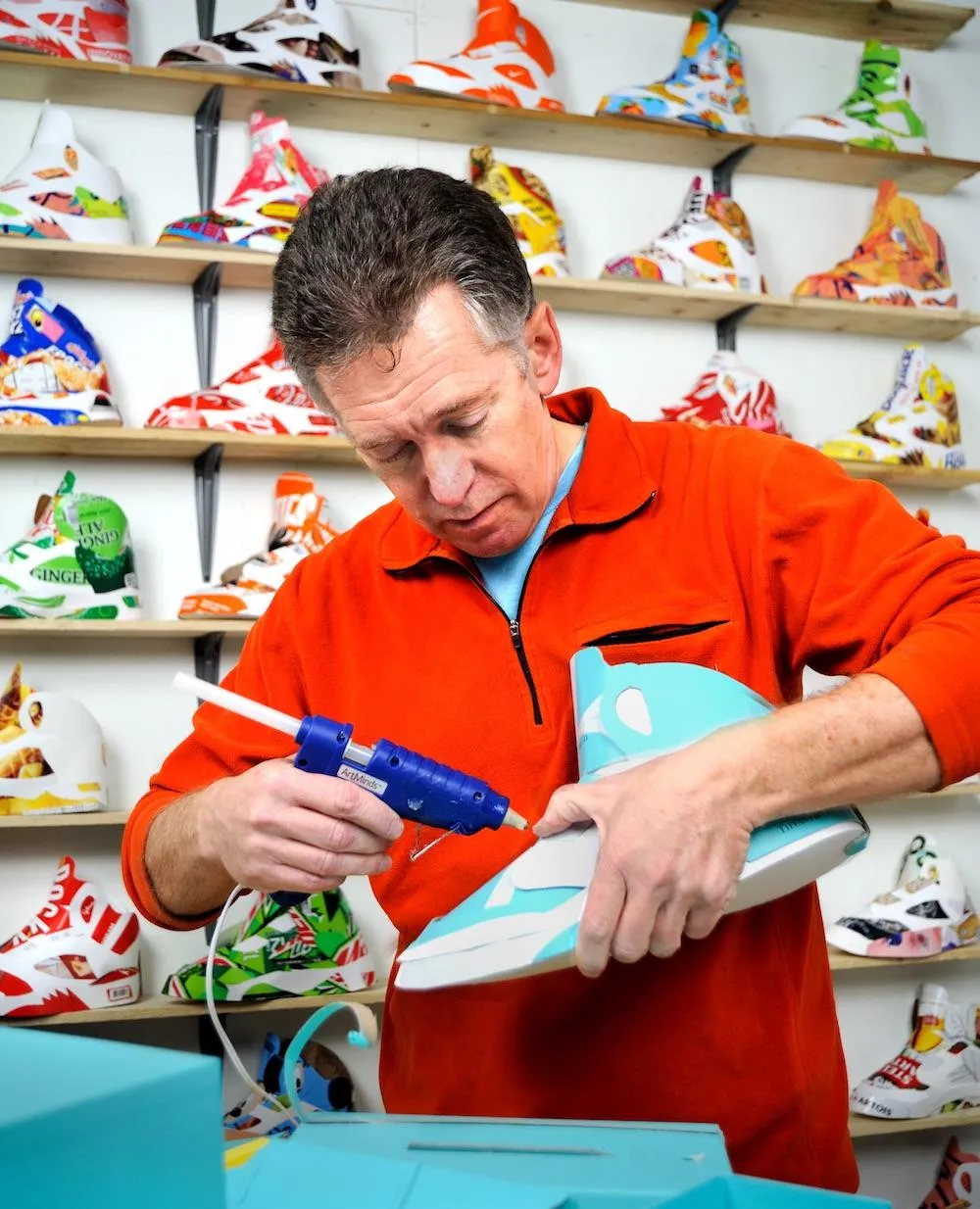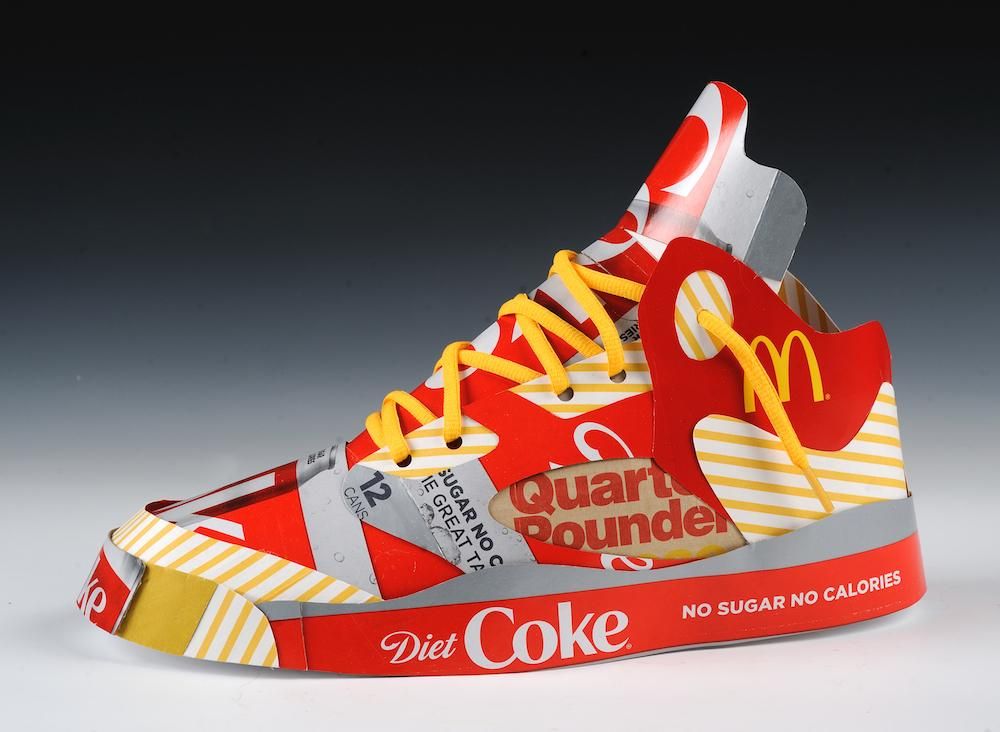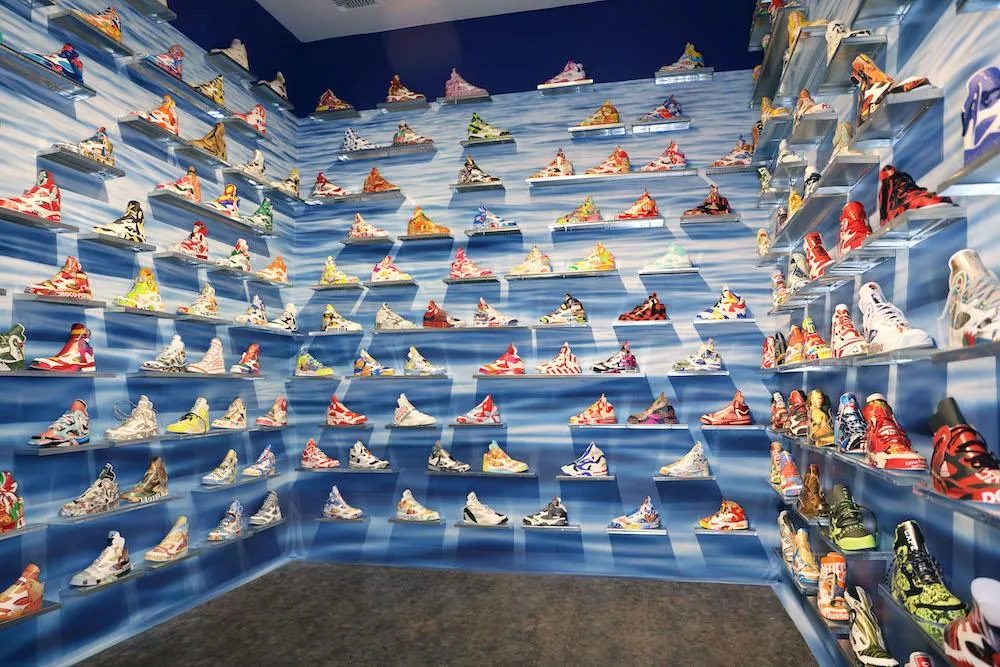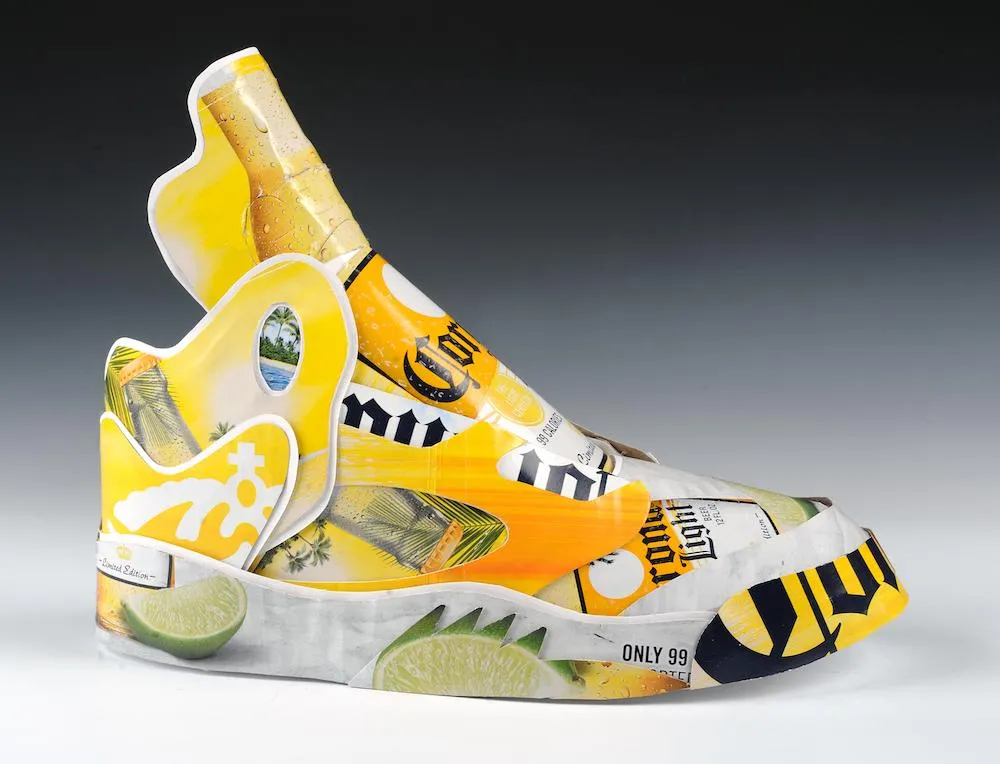Artist Fashions Nike Air Jordan 5s From Trash
Sculptor Andy Yoder’s latest exhibition is a nod to the Great Shoe Spill of 1990 and the advances in ocean science that came from it
/https://tf-cmsv2-smithsonianmag-media.s3.amazonaws.com/filer/7e/ae/7eae708a-b5e3-4c34-b668-83427a8a6273/2_studio_install_credit_greg_staley.jpg)
On May 27, 1990, the Hansa Carrier was traveling from South Korea to Seattle when a sudden storm pummeled the freighter and spilled its contents into the Pacific Ocean near the Alaskan peninsula. While the ship survived the squall, all of its cargo flew overboard, including several 40-foot steel containers holding 61,820 Nike sneakers. In the ensuing weeks, months and years, thousands of the shoes littered beaches across the Pacific Northwest.
Now, 30 years later, sculptor Andy Yoder is revisiting the incident known as the “The Great Shoe Spill of 1990” in a new solo exhibition. “Even today, a lot of people know about the shoe spill and have a rememberance of it,” Yoder says.
Called “Overboard,” the exhibition at the Brattleboro Museum and Art Center in Brattleboro, Vermont, features more than 200 replica Nike Air Jordan 5 athletic shoes created by the sculptor, the same type of sneaker that met its untimely fate in 1990 just as it was being released to consumers by Nike. But instead of working with fabric and thread, Yoder crafts each piece using trash he has foraged around his suburban Washington, D.C. neighborhood. The result is a colorful body of work that adds to the ongoing conversation about environmental protection.
“I think we’ve all become numb to the constant drumbeat [about saving the environment],” Yoder says. “It’s so dire and unavoidable, and the message needs to come at us in a different way that’s not too preachy or doomsday, and [this exhibition] is a backdoor way of doing just that. I wanted to look into how consumer culture effects the environment. When we buy something, it’s often manufactured overseas and travels by shipping container.”

Equipped with scissors and a hot glue gun, Yoder—no stranger to dumpster diving—has fashioned dozens of replica sneakers from discarded packaging emblazoned with the logos of well-known brands like Tiffany & Co., Coca-Cola, Corona Extra, Hot Wheels, Kellogg’s, McDonald’s and Nike (obviously). Displayed on shelves similar to what you would see at a shoe retailer, the 240 replica Jordan 5s intentionally call into question the environmental impact consumerism has on our planet.
“I like the idea of using these iconic brands, because I’m kind of hitching my wagon to their visual horsepower,” he says. “It’s that flash of recognition that draws people’s eyes to the shoes. And not only that, but shoes are also amazing as sculptural objects themselves; the form of them and their curves, and the way the shapes wrap around them. They’re a combination of form and function.”
Danny Lichtenfeld, director of the Brattleboro Museum and the curator of this exhibition, agrees, adding that Yoder's ability to make the topics of ocean pollution and excess consumerism approachable is what makes his art so brilliant.
“This exhibition let's us see things through the lens that [Yoder] views the world,” Lichtenfeld says. “He has hit upon a way to engage on those issues that's both playful and captivating, and grabs your attention and draws you in.”
Lichtenfeld says many of the pieces on display contain Easter eggs that will surprise viewers. “The way he manipulates the packaging materials and turns them into sneakers, revealing and hiding certain parts of the logos, is very clever,” he says. “Even the way he displays each object is creative. For instance, he has a Corona beer sneaker displayed next to a shoe he made from a box of Clorox bleach.”
Now 63, Yoder was 33 when the shoe spill occurred, and still in the early stages of his career as a sculptor, studying the art form at the Cleveland Institute of Art and later at the Skowhegan School of Painting and Sculpture in Maine. Over the years, he has regularly incorporated random everyday objects into his artwork; he has made dress shoes from licorice and a globe from matches. While he admits he doesn’t remember much about the incident when it happened, he says that the news did cause a frenzy among shoe collectors and beachcombers living along the West Coast, who scrambled to gather the sneakers as they reached land. Soon, collectors began setting up swap meets so that they could exchange salvaged shoes and find matching pairs. Remarkably, as The Seattle Times reported in 1992, the “shoes were still wearable after many months' battering by storms and water.”
While it should come as no surprise that sneakerheads would clamor for the chance to get free limited-edition shoes, an unlikely group was intrigued by the potential prospects these drifting sneakers presented: oceanographers.

Curtis Ebbesmeyer, an oceanographer based in Washington state who was studying oceanic dispersion and currents, was one of them. About a year after the 1990 accident occurred, and as more and more shoes reached land, his mother gave him a news clipping from The Seattle Times about the event, thinking he would find the story amusing.
“She asked me, isn’t this what you do as an oceanographer?” Ebbesmeyer recalls. “I told her I’d look into it.”
Inspired, he contacted Jim Ingraham, a former classmate from the University of Washington, which is where he earned his PhD in oceanography. After graduation, Ingraham had developed a computer program called the Ocean Surface Current Simulator (OSCURS) for the National Oceanic and Atmospheric Administration (NOAA) to calculate the effects of ocean currents on salmon migration. Ebbesmeyer hypothesized that if he gave Ingraham the unique serial numbers stamped on each shoe, along with the location of where the shoe spill occurred (point A), Ingraham could determine point B, or where each shoe would eventually wash ashore.
“With the [serial numbers] Nike provided, I could determine conclusively whether any shoe that washed up had fallen off the Hansa,” Ebbesmeyer writes in an article for University of Washington Magazine, published by his alma mater in 2009. “The first beachcombers' reports of sneakers washing up—“forerunners,” as one reporter called them [in the '90s]—were equally specific. I had something that's very rare with spontaneous flotsam (as opposed to determinate drift markers): both point A, when and where an object starts to drift, and point B, when and where it washes up."

Ebbesmeyer says that gathering information of where the shoes washed ashore and getting the serial numbers from Nike was the most time-consuming aspect of the project. Luckily, he found a beachcomber and painter living in Oregon named Steve McLeod, who had been keeping meticulous data of where and when 1,600 of the shoes were found. Ebbesmeyer and Ingraham inputed that data into OSCURS and were able to predict with certainty where the currents would sweep each sneaker.
“OSCURS homed in like a carrier pigeon,” Ebbesmeyer wrote, “making direct hits on the earliest point B's—November and December 1990 on the Washington coast and January and February 1991 on Vancouver Island—where the first sneakers washed up.”
In August 1992, they published their findings in the science news publication Eos. “As soon as that article published, my phone did not stop ringing,” Ebbesmeyer says. “Everyone wanted to talk to me about the shoes and ocean currents.”
By studying flotsam and hundreds of cargo spills over the years, Ebbesmeyer and Ingraham found that there are 11 major gyres or ocean currents spread across the planet, each with a different timetable of how long it takes an object to travel in its orbit.
“We studied hundreds of container spills and other flotsam and we found out that the ocean currents go in great circles, which I've been calling 'gyres,'” he says. “I found that the planet's oceans are covered with these gyres; [there are] about a dozen of them.”
By knowing the gyre where an oceanic incident occurs, be it an oil spill or a container ship losing containers full of sneakers, he can predict the circular direction the spill will travel and when it will reach land. Over the years, he's studied numerous oceanic spills, including hockey gloves and rubber duckies, and continues to publish a monthly newsletter called Beachcombers' Alert that reports on flotsam found in the ocean.
“I found out that my profession of oceanography didn’t study or utilize things that floated on the ocean’s surface, only what was underwater,” he says. “I thought it was a blind spot, so I started looking into container spills. My research wasn’t purpose driven, it was out of curiosity.”

That curiosity has made Ebbesmeyer into the world’s foremost expert on what he calls flotsametrics, earning him the title “oceanic gumshoe.” In 2010, he co-wrote a book on the subject called Flotsametrics and the Floating World: How One Man’s Obsession with Runaway Sneakers and Rubber Ducks Revolutionized Ocean Science.
Over the years, a number of cargo spills have made headlines, from hundreds of Garfield phones washing ashore in France to 28,000 rubber ducks hitting landfall along the East Coast, all of them a captivating reminder of the impact humans have on our planet. That connection is what artist Andy Yoder is hopeful will resonate when people see his Air Jordan exhibition.
“Picking the garbage out of the [dumpsters] to make my art is a lot like people pulling the shoes from the spill out of the water,” Yoder says. “There is a silver lining to the cargo ship incident.”
“Overboard” is on view both in-person and virtually through March 6 at the Brattleboro Museum and Art Center. Each shoe is available for purchase for $795, and some of the proceeds will help benefit the museum.